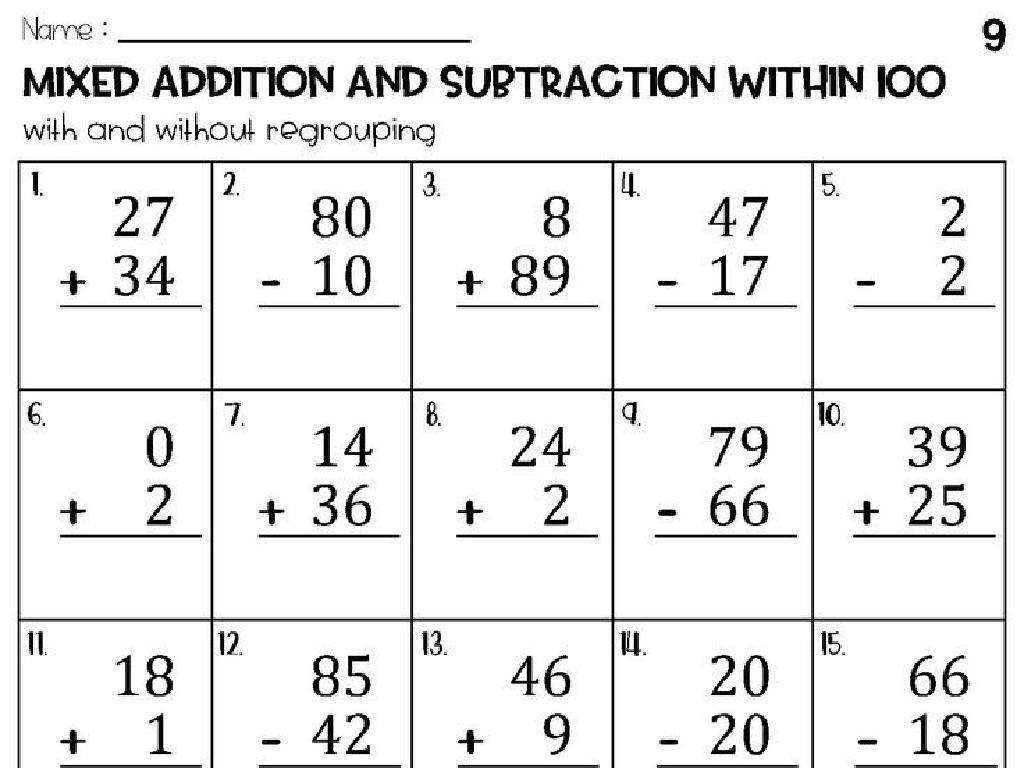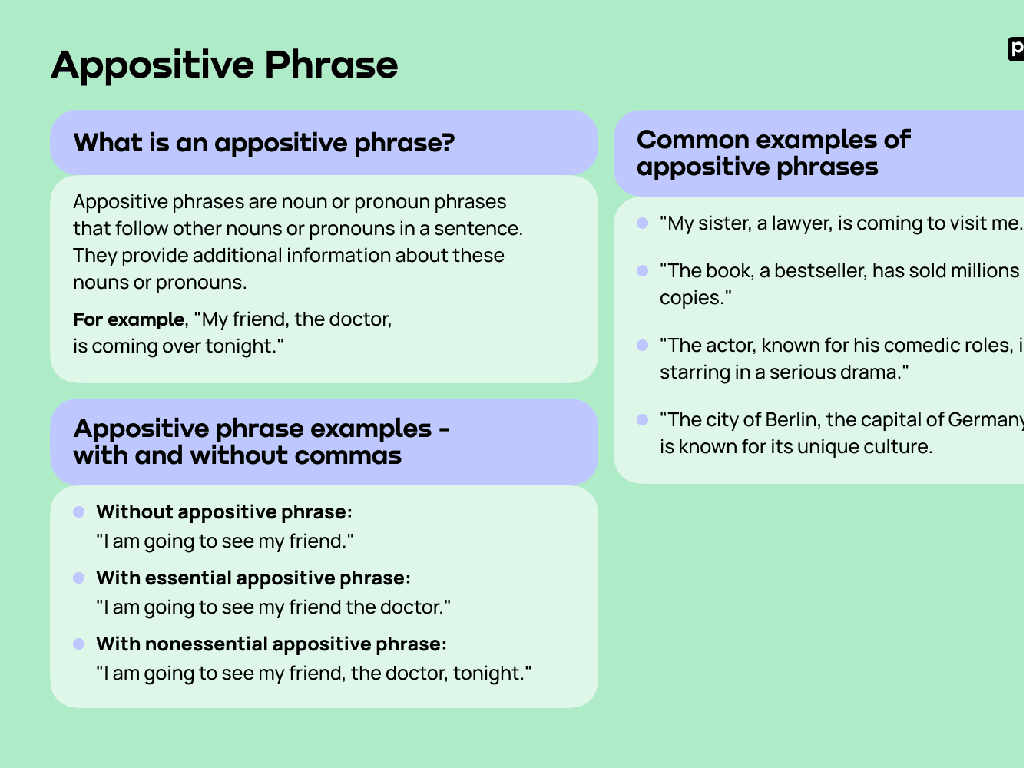Solve Equations: Mixed Review
Subject: Math
Grade: Eighth grade
Topic: One-Variable Equations
Please LOG IN to download the presentation. Access is available to registered users only.
View More Content
Introduction to One-Variable Equations
– Understanding equation balance
– Equations are like scales; both sides must be equal.
– Equations in daily life
– Use equations to budget, cook, or in construction.
– Review equation terminology
– Terms: variable, coefficient, constant, solution.
– Solving equations step-by-step
– Apply inverse operations to isolate the variable.
|
Begin the lesson by explaining that equations are like a balance scale, where both sides need to be equal. This concept is fundamental in understanding one-variable equations. Illustrate how equations are used in everyday life, such as budgeting personal finances, adjusting recipes while cooking, or calculating materials needed for building projects. Review basic terminology such as variables, coefficients, constants, and what it means to solve for a solution. Walk through solving equations step-by-step, emphasizing the use of inverse operations to maintain balance and isolate the variable. Encourage students to think of equations as puzzles to solve, and remind them that practice is key to becoming proficient.
Types of One-Variable Equations
– Characteristics of linear equations
– Linear equations form a straight line graph, e.g., y = 2x + 3
– Overview of quadratic equations
– Quadratic equations make parabolas, e.g., y = x^2 – 4x + 4
– Rational equations explained
– Rational equations involve fractions, e.g., (1/x) + 2 = 5
– Introduction to radical equations
– Radical equations include roots, e.g., sqrt(x) + 2 = 6
|
This slide provides a brief overview of different types of one-variable equations that eighth-grade students should be familiar with. Linear equations are the simplest type, with their most recognizable characteristic being their graph forms a straight line. Quadratic equations are a step up in complexity, forming parabolic shapes on a graph. Rational equations introduce the concept of variables in the denominator, while radical equations bring in square roots and other radicals. Encourage students to understand the basic form of each equation type and recognize their graphical representations. Provide examples for each to solidify their understanding and prepare them for solving mixed equation problems.
Solving Linear Equations: Isolate the Variable
– Understand equation structure
– Steps to isolate the variable
– Subtract 5 from both sides, then divide by 2
– Example: 2x + 5 = 15
– After simplifying, x equals 5. Verify by substituting back into the original equation
– Always check your solution
– Plug x=5 into 2x + 5 to see if it equals 15
|
This slide is focused on the process of solving linear equations by isolating the variable. Start by ensuring students understand the structure of an equation and the goal of finding the value of the unknown variable. Walk through the steps of solving an equation using inverse operations to get the variable alone on one side. Use the example 2x + 5 = 15 to demonstrate these steps: subtract 5 from both sides to get 2x = 10, then divide both sides by 2 to find x = 5. Emphasize the importance of checking the solution by substituting the value of x back into the original equation to ensure it satisfies the equation. This reinforces the concept and builds confidence in their problem-solving skills.
Solving Quadratic Equations
– Factoring quadratic equations
– Break down into (x-2)(x-3)=0, solutions are x=2, x=3
– Example: x^2 – 5x + 6 = 0
– Set equation to zero, factor to find x values
– Using the Quadratic Formula
– Apply formula: x = [-b ± (b^2-4ac)]/(2a)
|
This slide introduces students to solving quadratic equations by factoring and using the quadratic formula. Start by explaining that a quadratic equation is an equation of the second degree, meaning it contains at least one term that is squared. The first method of solving is by factoring, where students look for two numbers that multiply to give the constant term (ac) and add to give the middle coefficient (b). Use the example x^2 – 5x + 6 = 0 to illustrate this, showing that the factors of 6 that add up to -5 are -2 and -3, hence the factors of the quadratic equation are (x-2) and (x-3). Next, introduce the quadratic formula as a universal method that works for all quadratic equations, even when they can’t be factored easily. Emphasize the importance of substituting the correct values for a, b, and c from the equation into the formula. Provide additional examples for practice and ensure students are comfortable with both methods.
Solving Rational Equations
– Find a common denominator
– To add or subtract fractions, find a common denominator, e.g., x(x-1)
– Solve 1/x + 2/(x-1) = 3
– Multiply through by x(x-1) to clear fractions, then solve for x
– Check for extraneous solutions
– Verify solutions don t make any denominator zero
|
This slide introduces students to solving rational equations, which are equations involving fractions with variables in the denominator. Start by explaining the necessity of finding a common denominator to combine the fractions. Use the example 1/x + 2/(x-1) = 3 to demonstrate the process of multiplying through by the common denominator to clear the fractions and then solving the resulting equation. Emphasize the importance of checking for extraneous solutions, which are values that make any denominator zero and are not valid solutions to the equation. Provide additional practice problems for students to solve, ensuring they understand each step and the rationale behind checking their solutions.
Solving Radical Equations
– Isolate the radical expression
– Solve example: (2x+3) – 4 = 0
– Add 4 to both sides, then square to remove the radical
– Square both sides of the equation
– Squaring may introduce extraneous solutions
– Check your solution
– Substitute back to verify the solution is correct
|
This slide focuses on the steps to solve radical equations, which are equations that include a variable inside a radical, typically a square root. Start by isolating the radical on one side of the equation. For the example (2x+3) – 4 = 0, add 4 to both sides to get (2x+3) = 4, then square both sides to eliminate the radical, resulting in 2x+3 = 16. After solving for x, it’s crucial to check the solution by substituting it back into the original equation because squaring both sides can introduce solutions that don’t actually satisfy the original equation. Encourage students to practice with additional examples and to always verify their answers.
Solving Equations: Mixed Review
– Apply learned solving techniques
– Use techniques from past lessons for new problems
– Solve diverse equation types
– Linear, quadratic, and variable on both sides
– Discuss strategy selection
– Choose the best method for each equation type
– Review and practice problems
|
This slide aims to consolidate students’ understanding of solving different types of one-variable equations. Encourage students to apply the techniques they’ve learned in previous lessons to a variety of new problems. This mixed review will include linear equations, quadratic equations, and equations with variables on both sides. Discuss with the class how to select the most effective strategy for solving each type of equation, whether it’s simplifying, factoring, or using the quadratic formula. Provide a set of practice problems for students to work on individually, in pairs, or in small groups, and then review the solutions as a class to reinforce their learning.
Class Activity: Equation Relay
– Form groups for equation relay
– Solve assigned one-variable equations
– Use inverse operations to isolate the variable
– Each group presents their solution
– Explain steps taken to solve the equation
– Discuss the variety of methods used
– Compare and contrast different solving techniques
|
This activity is designed to promote teamwork and enhance problem-solving skills. Divide the class into small groups and assign each group a different one-variable equation to solve. Encourage the use of inverse operations such as addition, subtraction, multiplication, and division to isolate the variable. After solving, each group will present their solution and the method they used to the class. This will be followed by a class discussion where students can compare different approaches, discuss which method they found most efficient, and why certain methods work better for certain types of equations. Possible activities for different groups could include solving for a variable in simple equations, multi-step equations, equations with variables on both sides, or equations involving fractions or decimals.
Lesson Recap & Homework
– Summarize today’s equations
– Practice with mixed problems
– Solve assigned problems for reinforcement
– Ask questions if unsure
– Clarify doubts to strengthen understanding
– Review solutions next class
|
As we conclude today’s lesson on solving one-variable equations, it’s important to summarize the key concepts covered. Assign a set of mixed review problems that encompass the various types of equations discussed. This will serve as practice to solidify students’ understanding. Encourage students to ask questions about any part of the lesson they are unsure of; this can be done in class, via email, or in a designated online forum. Let them know that we will review the solutions in the next class, which will help them correct any misunderstandings and learn from their mistakes. The homework is not only a review but also a critical thinking exercise designed to prepare them for more complex problem-solving in the future.






